This web page describes at trip with the traditional Greek Perama S/Y Faneromeni from Çanakkale in Turkey to Istanbul. The places visited, all in Turkey, are: Kemer, Marmara Island, Princes’ Islands, and Istanbul. It is illustrated with maps and photographs, also included are some historical and geographical descriptions of the places visited as well as several links to other related web sites.
Note: A portion of his passage is also described by my brother Nikos Riginos in his Faneromeni website.
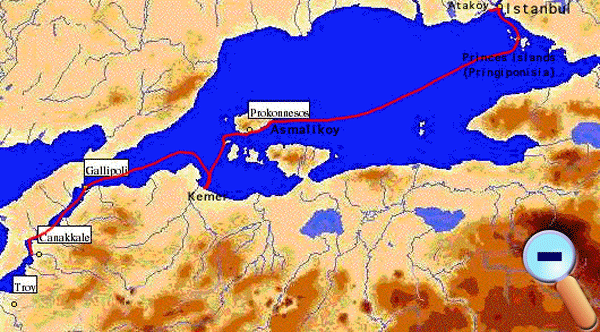
Thursday June 4, 1998 (after 2:00 pm) Day 4
We finally departed Çanakkale at 1420. We motored against the wind (10-18 knots) with some spray but it was tolerable. The traffic in the Dardanelles was, as always, very heavy. As we were approaching the end of the channel the wind diminished to less than 5 knots and the sea turned from choppy to flat. Within the channel there were strong eddies and a current of about 2 knots running west. We were now in the Sea of Marmara (Προποντίς — Propontis).
At 1955 after 43.7 M we reached Kemer [40° 25.3' N 27° 03.8' E] where we anchored just west of the harbor, taking a long line to the rocks of the jetty. The sea was perfectly calm and very muddy with a green-brown color—you could not see the bottom even at a depth of 25 cm which was very hard on the nerves of these Aegean sailors. There were several children and grown ups watching our maneuvers and many came to help with the line. There were 2 other sail boats: one with French and the other with British flag, both of which we had seen in Çanakkale.
We took the inflatable ashore to the harbor which was full of fishing boats, some very large and made of rusted iron. The water inside the harbor was so full of Diesel oil and other pollutants that we did not land lest we diry the inflatable. We landed instead at a very modest hamlet just south of the harbor. We were instantly surrounded by at least 6 people, mostly fishermen plus the better dressed town barber, who invited us to have some çay (tea) with them. They were very, very, friendly and we all managed to communicate our mutual good will despite the lack of any common language.
Later we installed the repaired head and its new base and cooked pasta with tomato sauce.
Friday June 5, 1998 Day 5
We left Kemer at 0715 heading for the Marmara Adasi (Προκόνησος — Prokonisos). The water in the Sea of Marmara was green and opaque. Unlike the night before, there was some chop and spray. The sky had broken clouds and, once again, we could not sail, so we were motoring. The situation was tolerable but weather-wise not too attractive.
We arrived at Port Marmara [40° 35' N 27° 33.6' E], the largest town on the island, but it was not very inviting so we proceeded to the East of the island to Asmaliköy [40° 36.9' N 27° 42.4' E] (Αφθόνι - Afthoni) where we arrived at 1215 having covered 36.2 M. We anchored and came stern-to without any difficulties other than that near the pier it was too shallow and our rudder touched the bottom, which was fortunately very soft, and we had to use fairly long lines. The place was very attractive, totally untouched by the outside world despite its relative proximity to Istanbul. Marmara Adasi is the largest island in the Sea of Marmara. Its peak is 720 m above sea level. Its south side is very wooded and green while its north side is very heavily quarried for marble.
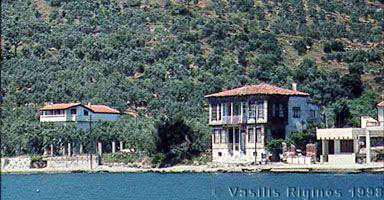
We walked to the little hamlet and once again we were invited for tea (çay) and we met all the local men who were smiling and were very friendly but again our communication was at a rudimentary level. We were only able to buy some wonderful bread at the çay hani (tea house) since the very basic little store had neither bread nor fruits nor bottled water.
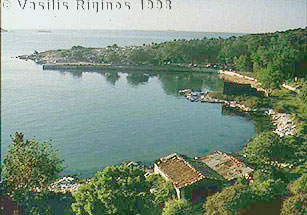
We spent the afternoon cleaning the boat, whipping some frayed lines, and doing other housekeeping tasks. While doing these things we were harassed by a group of young boys who kept yelling at us: “Hallo! Hallo!” louder and louder for over an hour. The less attention we paid to them the more strident they became. We were rescued by the arrival of the private gulet Turkoglu, whose captain as soon as he appraised the situation just said a few soft words and, as if he had waved a magic wand, all the young fiends vanished. They were soon replaced by another group of older boys who were diving and swimming around the Faneromeni and the Turkoglu. Not only they did not bother us but when we, by accident, dropped a cushion overboard they dove for it and retrieved it for us. We invited them to see the boat and they were delighted.
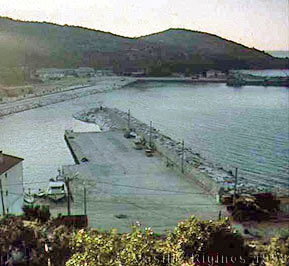
In the early evening we deployed the little motorbike and we drove up the steep dirt road through many sycamore trees and green vistas to Saraylar (Παλάτια - Palatia), the port from where the marble is loaded. It is an attractive town but it is surrounded by the moonscape of the marble quarries. The island has been quarried for marble since antiquity. The harbor is totally built of marble blocks and it is decorated by ancient column segments and other architectural fragments—all of the marble rejects of ancient craftsmen. The place was crowded with young men, most likely imported workers for the quarries. There was not a single woman in sight! The whole waterfront has a depressed look and one can easily imagine that we were in a much older period than the late 20th century. We had a nice meal of grilled steak, rice, and salad at the only restaurant. We also bought 3 bottles of water and some fruit. By the time we started on our way back to Asmaliköy it was getting dark and we had considerable difficulty carrying our groceries on the tiny bike. On the way, we scared several owls which seemed totally surprised that a vehicle was moving at that hour. We did not encounter any traffic.
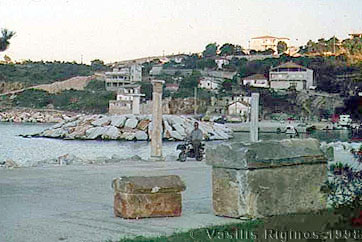
Saturday June 6, 1998 Day 6
We left Asmaliköy at 0610 and motored to the Princes’ islands, just a few miles south of Istanbul. We had both heard from people living in Istanbul about the beauty of these islands. There are four principal islands and several smaller ones. According to Heikell (author of the Turkish Waters Pilot) there is only one very secure anchorage on the Heybeliada island: Can Limani , so we headed for there. The sea was similar to yesterday’s: slightly choppy. There was a low NW wind, and it was partly cloudy. On the way I did some laundry.
Yesterday the Navtex which we had connected to another antenna that we taped on the shrouds miraculously did receive a few messages but since last night it had stopped receiving. Neither of the cellular phones could receive a signal there.
We arrived at Can Limani [40° 52.2' N 29° 05.1' E] at 1430 having covered 65.4 nM. There were several cruisers and a few sailboats anchored offshore but other than two large buildings there was not any activity ashore.
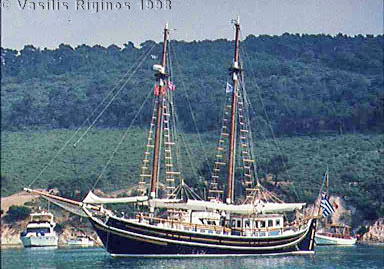
The Faneromeni in Halki |
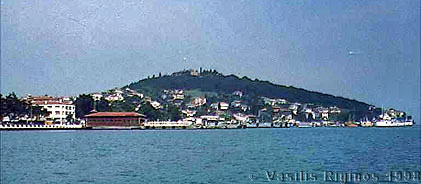
Halki |
After launching the inflatable and installing the large 30 hp outboard, we motored to the town located a few miles NE of the cove. In the town there were substantial old building, mansions of days long gone by. The town was bustling with people who seemed to have come for the day with the small ferryboats that were constantly coming and going.
Nikos heard a lady talking with her daughter in Greek and asked her which one of the Princes’ islands is Halki (the Greek name no longer used) famous from the Byzantine times for its theological school and later as a resort of wealthy Greeks. She told us that we were actually on Halki. She is Greek living in Istanbul. The Princes islands (Πριγκηπονήσια — Pringiponisia) are: Pringipos (Πρίγκηπος) or Büyükada, Halki (Χάλκη) or Heybeliada, Antigoni (Ἀντιγόνη) or Burgazada, and Proti (Πρώτη) or Kınalıada. Their Turkish names are very recent and seem to me as an effort to erase the deep Greek roots of the area, similar to Argentina renaming the Falklands to Maldives and Greece renaming Tourkolimano to Mikrolimano.
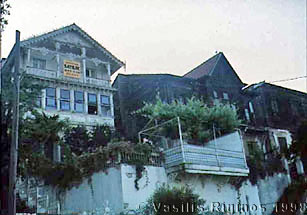
We sat at one of the many restaurants by the esplanade and had a snack while watching all the people come and go. Nikos had brought with him his mobile phone and we called Alice in Chicago where she was visiting her mother, Byron our brother in Athens whose birthday it was that day, Rozina, and our mother. We then did some light food shopping, mainly bottled water, and headed for the small boat harbor where we had left the inflatable.
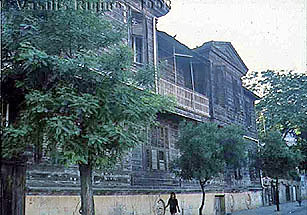
As we were getting in the inflatable two men spoke to us in Greek. One of them spoke fluently. He is the owner of a small fishing fleet and has worked for many years aboard a Greek freighter. He confirmed that indeed we had the Faneromeni in the safest anchorage in the islands and invited us for a drink. As we were very lightly dressed and the day was getting on and we were feeling the chill we thanked him and promised to meet with him tomorrow. We had hardly untied the boat when again we were spoken to in Greek by a young man who introduced himself as Costas Anannides. He is one of the Greek inhabitants of the island. He lives with his family in a lovely old house overlooking the harbor. He was with his elderly father who owns an old-fashioned little motor cruiser made of mahogany. They run a machine shop in Istanbul. They gave us a lot of information on anchorages in the Istanbul region, places to see in the islands, in the city etc. They said that we must go and visit the Patriarch who loves the sea and keeps his own boat at the Ataköy marina.
By the time we disengaged from these friendly people we were very cold, but nevertheless we drove with the inflatable across the narrow channel to Pringipos island. The houses here are also large and very well kept. Some are magnificent villas and overall there is an air of great opulence. While we were too cold to land, we decided to come back the next day.
Back at the anchorage we were welcomed by Argos. Many more boats had arrived for the night. The Navtex had resumed reception. The sea was perfectly calm, but it was totally opaque and a deep green color while the bottom appeared black and there was a lot sea weed floating and fouling everything. This was the first warm evening we had had since we left Lesvos, warm enough for a nice after dinner stroll ashore.
Sunday June 7, 1998 Day 7
Early in the morning Argos and I took a brisk walk up the hill. The large ugly institutional buildings we had seen from the boat are even uglier close up. One of them is a sanitarium. Groups of 4 to 6 men carrying plastic bags and boom-box radios were drifting down the hill to the seashore. When they reached the shore they took off their shirts and spread a picnic from their bags. Each boom-box was playing different music and competed in loudness with its neighbor. Unfortunately they all seem to leave their garbage behind and the beach was very littered.
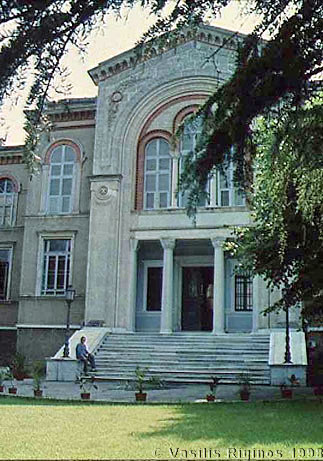
Later we took the inflatable to town and walked up the steep road to the Halki Theological School which is part of a monastery. The building is large and imposing. The enclosing gardens are well kept and lovely with many colorful blooming flowers. From the central church were emanating very melodious Byzantine chants. I hesitated to enter the church since I was not properly dressed. Nikos, who was wearing long pants, entered and after the end of the service he emerged accompanied by a gentleman who gave us a tour of the school. It is as imposing from the inside as it is from the outside. All the classrooms are clean and it is furnished by old, well polished, wooden furniture. There used to be 300 students here until 1971 when the school stopped operating by order of the government. The Patriarch is very active in trying to obtain permission for the school to function again. We were shown the dinning room and the reception room all very opulent. All the signs, including the large plaque at the entrance, are exclusively in Turkish. It is a piece of Byzantium in moth balls transported to modern Turkey. Very strange!
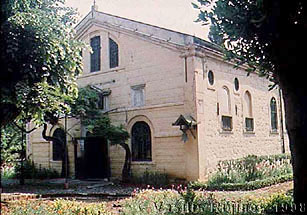
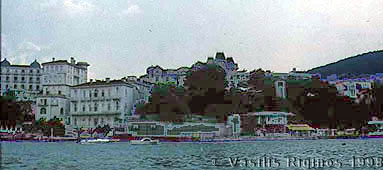
Afterwards we got back in the inflatable and went across to the Pringipos (Büyükada) island where, after tying the boat at a high pier, we took a horse drawn buggy for a tour of the island. On all the Princes’ islands there are no motor vehicles allowed. There are no cars, nor motorcycles, nor scooters, save the garbage truck and a couple of police motorcycles. People and goods are moved by horse-drawn carriages and carts. It is very smart and makes a huge difference in the overall ambiance. There are many old fashioned, very plush hotels, and mansions, all with beautiful gardens enclosed by intricate ironwork fences and gates. It is a very attractive and extremely prosperous place. After the carriage ride we walked among the crowd which seemed to have come for the Sunday. This would be a lovely place to stay.
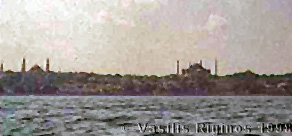
We took the inflatable back to the Faneromeni and started preparing for departure. We raised the anchor at 1445 and motored toward the Bosphorus, the narrow channel that separates Europe from Asia. On the way we were hit by a violent thunderstorm which cut the visibility to almost zero. Thank goodness for the radar, as these waters are extremely crowded with vessels of every description and size. We entered Bosphorus and slowly motored as far as the Bosphorus Bridge. The view was breathtaking with Agia Sophia, the Blue Mosque, and the Topkapi on one side, the palaces which lined both sides, and the traffic in the narrow channel. Boats were everywhere: large steamers comming from or going to the Black Sea, ferryboats cutting across at high speed, cruise ships, motor cruisers, small fishing boats, even a couple of sail boats all in an anarchic mess, totally oblivious of any rules of navigation avoiding each other, as if by miracle. The water was very polluted.
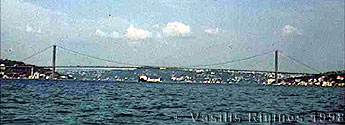
The Bosphorus Bridge |
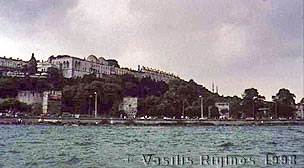
View of Istanbul from the sea |
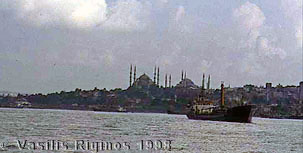
After this “sightseeing” ride we headed west to the Ataköy Marina where Nikos’ friend Mr. Murat Susa had made arrangements for berthing the Faneromeni while visiting Istanbul. In front of the city there were numerous anchored steamers. We were overcome by another thunderstorm of extreme violence and once again had to proceed through the water traffic with almost zero visibility. Even with the radar it was still a dangerous and tense experience. As we were approaching the marina, we tried to hail it on the VHF channel 73, as we had been instructed, but there were so many simultaneous conversations going on that it was doubtful if they had even heard us. When we were almost at the entrance of the marina [40° 58.3' N 28° 52.6' E] we were eventually contacted. It was 1830 and we had covered 28.6 M. We were told to wait and, after almost half an hour, we were shown to our berth by an inflatable. The attendants helped us tie the lines and gave us a permanent mooring; we had no problems. We were surrounded by large, luxurious motor cruisers.
Monday June 8, 1998 Day 8
During the night there was a very heavy downpour. Poor Argos did not like it at all! It was very exiting to wake up and realize that we were in Istanbul the capital of the Byzantine empire Κωνσταντινούπολις (Constantinoupolis — the city of Constantine) or, as it is known to all the Greeks, simply as η Πόλις (i Polis - the City).
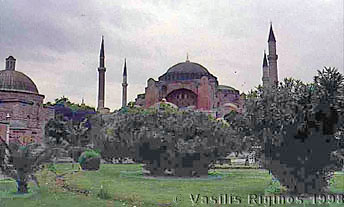
In the late morning we drove with the motorbike to the Hagia Sophia, the Byzantine Cathedral of Constantinoupolis, now a museum. Unfortunately it, as most other museums, was closed on Mondays so we were only able to admire this architectural wonder from the outside. The little Honda foldable motorbike has been an item of great curiosity ever since we arrived in Turkey. People stare at it, want to touch it when parked, and laugh when they see two grown men riding it. Unfortunately in front of the Hagia Sophia it attracted the attention of all the street vendors and hustlers from whom we had a very hard time extricating ourselves. Here let me make a small parenthesis. While I love traveling in Turkey and I am very fond of its polite and hospitable people, its merchants drive me up the wall. One dares not even look at a window without risking being assaulted by the proprietor and hassled to enter the emporium. I, for one, would have purchased much more had I been left on my own devices since by nature I am contrary and resist any pressure tactics.
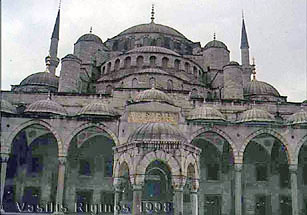
We were fortunate that while most museums were closed, the Blue Mosque was open. We were able to see it thoroughly from both the outside and the inside. It is indeed a magnificent building and its combination of ceramic tiles, stained glass windows, and colorful carpets make the visit to its interior a virtual aesthetic feast. We lingered there for a while. When we returned to where we had parked the motorbike, we found two policemen scrutinizing it. For a while we thought that we were surely in trouble because we were parked on the sidewalk which is most likely illegal, but no, they were just curious about this strange machine and they wanted to know, like almost everyone else, how much we had paid for it. They were rather disappointed when Nikos said that he has had it for over 10 years and does not remember how much he had actually paid when he bought it, already used. They shook their heads with disappointment as such an ignorance. Nevertheless, they gave us instruction on how to go to the Topkapi, our next destination.
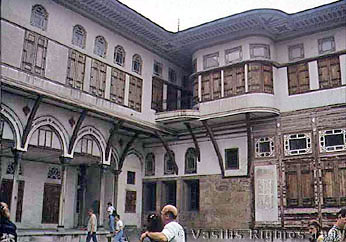
At the entrance of the Topkapi Palace there were several soldier guards. They too were curious about the motor bike. Contrary to the write-up of our tourist guide both the palace and the exhibits were open. We were able to see the magnificently illuminated manuscripts, the Prophet’s bow and sword, the famous Topkapi Dagger (remember the Topkapi movie with Melina Merkouri and Peter Ustinov), the Spoonmaker’s Diamond, etc. We also visited the harem section which was opened to the public just a few years ago. It is really hard to see how about 400 women were kept indoors, prisoners for life, in such a small, although gilded, cage. We then walked around the gardens but heavy rain hindered further explorations.
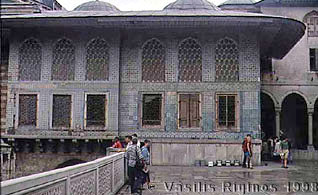
The Harem |
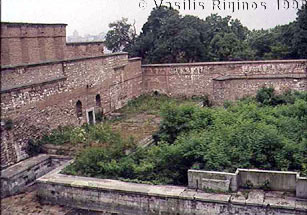
The Harem’s garden |
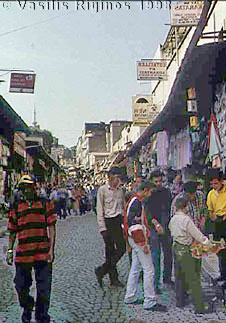
After the rain stopped, we drove to the Grand Bazaar and wandered in its endless stoas and narrow streets dodging the all too eager vendors. The size and scope of the Bazaar is impressive.
We then drove through the infamous Istanbul traffic to the Dolmabaçe Palace, which was unfortunately closed, but we sat at the cafe in the Bosphorus Park and admired the view and the comings and goings of the water traffic while sipping our coffee.
Back on the bike and through the heavy traffic and the noxious fumes we rode to the marina and the Faneromeni. The large motor cruiser that had been next to us was gone.
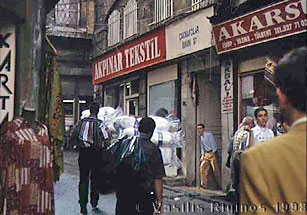
Later, while we were having our showers, somebody was calling “Faneromeni” in Greek. He was a business-suited gentleman (Mr. Makis) who introduced himself as a secretary of the Patriarchate. He was at the marina with a limousine and a minibus and, as he explained, he was waiting for the arrival of the missing cruiser which had taken the Patriarch (the equivalent of the Pope for the Orthodox Christians) for a day excursion to Halki. In the morning, while boarding the cruiser, the Patriarch’s interest was raised by the Faneromeni and her lovely blue and white colors and her large Greek flag. Mr. Makis, who was not only aware that we had arrived last night from Halki, but that we had spent the afternoon in the Grand Bazaar and were overheard talking between us in Greek, explained that the Patriarch loves boats and would like to meet us when he returned to the marina. We were flabbergasted! It seems that the Greek community in Istanbul, while not large, has an excellent spy network. Soon enough the cruiser came in. On board was, as expected, the Patriarch with a large entourage of Orthodox clerics and a Greek-American family, the Georgiades from Greenwich, Connecticut consisting of father, mother, daughter, and 2 grandchildren. Mr. Makis introduced us to the Patriarch and the Georgiades. The Patriarch Bartholomew, after coming aboard the Fanertomeni, explained that he loves the sea and admired the Faneromeni as an excellent example of a Greek traditional sailing boat. He invited us to visit him at the Patriarchate and was sorry to hear that I would be leaving tomorrow but insisted that Nikos should not fail to visit him next Sunday when the Greek Archbishop would be there so that he could introduce them. The Patriarch seems a very personable and intelligent man, who despite his exalted position, enjoys such simple things as boating. The Georgiades will also be leaving tomorrow for Athens where they will board a chartered motor cruiser and will be cruising the Cyclades and Amorgos. Maybe we will meet again …
Tuesday June 9, 1998 Day 9
We hailed the marina on the VHF and arranged for a taxi to pick me up and take me to the airport. Everything worked fine. The taxi did come at the appointed time and the friendly driver drove me to the airport while we engaged in conversation. At the Olympic Airways terminal, however, everything fell apart! The flight I was booked on had been canceled and the young lady at the counter told me that since I had not come 2 hrs before the scheduled time, but only 1½, I just had to come back tomorrow. I, of course, put up some resistance to this suggestion and asked if there were available alternate routings to Athens. She told me that there was a 3:00 PM flight to Vienna from where I could take a flight to Athens arriving after 11:00 PM. I was not thrilled and pressed her for something better.
At this time Mr. Dimitris Papinis, the local manager, had arrived. He noticed my duffel bag and asked if I was a seaman. I explained that I was a sailor and had come to Istanbul from Greece with a caïque. It turns out that he is an ex-merchant marine and an avid sailor himself. He looked at the computer terminal and after some typing he came up with a much better routing via Milano which would get me to Athens at 6:00 PM. The rub was that the Turkish Airline flight to Milano was due to depart in a few minutes. He rung to the Turkish Airline counter and asked them hold the flight while the young lady reissued my ticket. We then all ran to the Turkish counter and checked my bag and then we all three ran to the gate while Mr. Dimitris was taking down Rozina’s number to notify her of the changes in my arrival. The plane was indeed waiting for me, I caused it a 5 minute delay!
From Milano I also called Rozina. Mr. Dimitris, true to his word, had called her also. I landed in Athens at 6:15 PM and was met at the airport by Rozina and my wife Alice who had arrived from Washington, D.C. just a few hours ago.